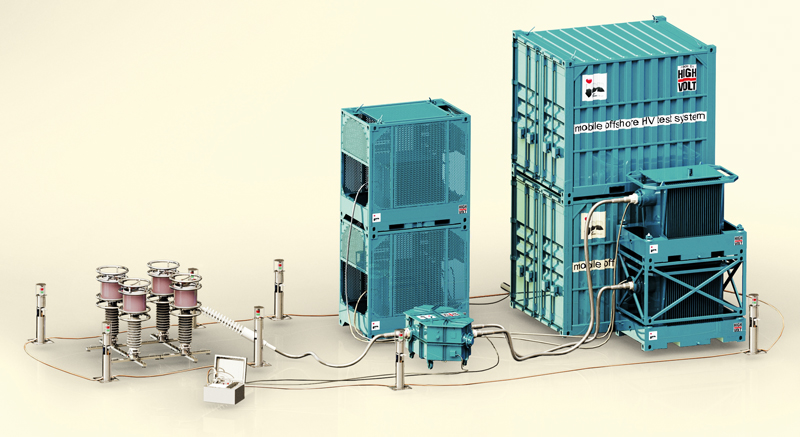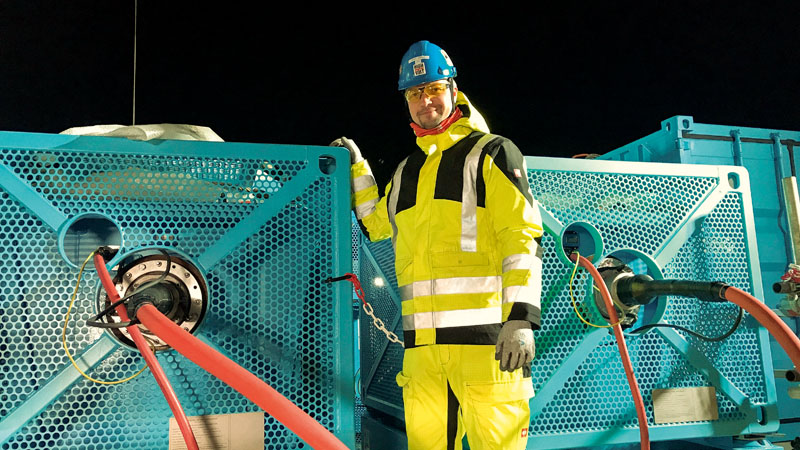Stormy seas, salty air, snow or rain—how are cables of offshore wind turbines supposed to be tested? HIGHVOLT has found a solution. It has now been used for the first time.
1. The challenge
More offshore wind parks continue to be built at larger and larger sizes around the world. At the same time, the generative performance of wind turbines is steadily increasing, and with it the operating voltage of the connection cables from the wind turbines to the collection and connecting platforms, sometimes at a distance of over 30 kilometers. A capacity of 66 kilovolts has become common, and higher voltages up to 145 kV are being discussed. In 2019, the experts at the International Electrotechnical Commission (IEC) therefore decided to permit — alongside the soak test (a 24-hour test at nominal voltage) — only resonance testing for operating voltages greater than 36 kilovolts in the new IEC 63026 standard for submarine cables up to 72.5 kV.

For cables with a nominal voltage greater than 110 kV, this has been standard for decades. But how do I get such a testing system to the switchgear and converter platform? In the middle of the ocean? And while dealing with wind and weather? The industry needed a solution urgently for testing cables after installation and finding the source of error in case of a later defect. Otherwise, electricity will not reach the shore.
2. The Solution
The testing experts at HIGHVOLT are working to make their proven resonance testing system fit for use at sea. First, there were extensive discussions with installers and operators of wind parks, cable manufacturers, service providers and certification companies in order to clarify the specifications and procedures for transport, setup and operation. As a result, it was clear that the testing system needs to be much more rugged than its counterpart on land because of the rougher conditions at sea. The requirements for the materials and operation are also completely different due to the weather conditions.

Another restriction is the load capacity of cranes at sea — 3.7 tons is the magic number up to which there are no restrictions. Finally, there is also the DNV certification, an important prerequisite to allow the system to be transported at sea, ferried to the platform and operated there.
The engineers at HIGHVOLT reworked the testing system and divided it into several modules in order to meet the weight specifications. Reactors and exciter transformers have been integrated into the transport frame, which simultaneously protects them, and open high-voltage connections are designed as shielded cables. To ensure that all materials, paints and weld seams satisfy the special requirements of maritime use, HIGHVOLT worked together with experienced shipbuilding engineers and a specialized shipyard. Only twelve months after the initial sketch, the testing system at the HIGHVOLT plant in Dresden was ready for its first use in the field.
3. The first Application
The HIGHVOLT test system saw its first application by an offshore wind park operator in the North Sea in November 2021. The wind park is almost finished, and the operator has to check whether the cables were installed without errors. Experience tells us that more than half of all cases of faults can be traced back to faulty cable installations.

The weather on site showed off its full range, from sunshine to violent gusts of rain and ice — this application had everything this time of year typically has to offer. A HIGHVOLT service engineer was also on site in order to commission the system and support the operator’s personnel during the electrical tests. To even be allowed on the platform, HIGHVOLT qualified three service engineers for offshore work assignments.
To be qualified, they needed to jump into the ocean from a height of twelve meters with a rescue device, free themselves from a sinking helicopter and practice working at high altitudes. Because work on a platform is anything but safe. Since construction work is still taking place during the day, the cable tests were carried out on the night shift. Afterwards, the work of the HIGHVOLT service engineer was done for the time being and the operator was able to bring the testing system to the next place where it is urgently needed.
YOUR CONTACT

Do you have any questions about the testing system?
Dr. Mario Jochim would be glad to answer your questions:
m.jochim@highvolt.com
